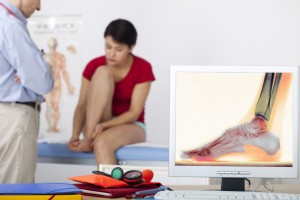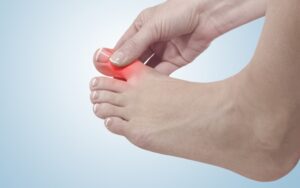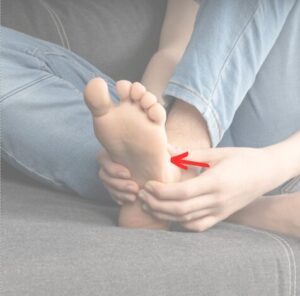Help! I think I have Plantar Fasciitis! It is one of the most common things we hear here at the Chelsea clinic, South Kensington
We hear all to often clients complain of:
- Heel pain
- Painful walking with the first few steps in the morning
- Feet sore after rest
- Pain walking on heel
Plantar Fasciitis is one of the most common causes of heel pain and I’m sure we have all known someone who has it.
Thankfully here at the Chelsea clinic we are experts in diagnosing and treating this condition.
What is Plantar Fasciitis?
The plantar fascia is a tissue that runs along the sole of the foot connecting the heel bones to the toes, creating the arch of the foot.
When the plantar fascia is overstretched, it becomes inflamed and that is what we call plantar fasciitis. Plantar fasciitis occurs when there is a stress on the plantar fascia.
Try to think of plantar fasciitis as a rope pulling away from the heel bone causing heel and arch pain.
If tension and stress on this becomes too much, it can lead to the development of small tears, causing irritation and also inflammation.
Pain may occur either where it inserts into the base of the heel bone causing heel pain, or along the sole of the foot between the heel and the toes.
Also, plantar fasciitis can lead to intense, chronic heel pain if the cause of the pain is not addressed, with the severity varying person to person.
Ignoring plantar fasciitis may result in chronic, long term heel pain or heel spurs which impacts on day to day activities. In more complex cases, there may also be a burning and tingling pain described.
Risk factors of Plantar Fasciitis
- Age – most commonly we see plantar fasciitis occur between the ages of 40 and 70 – particularly in those who are more active.
- Poor footwear – shoes which lack support around the heel and arch area, with thin, over flexible soles can cause plantar fasciitis. Loose fitting and non-shock absorbing footwear such as flip flops provide inadequate foot protection and support.
- High impact activities – running, dancing, jumping activities put a lot of pressure on the soles of the feet.
- Foot type and mechanics – a flat foot, high arch, or pronation (fallen arches) can affect the weight distribution and can also put too much strain on the plantar fascia.
- Tight, shortened calf muscles and Achilles tendon – when the calf muscles and Achilles’ tendon are tight and tender, it usually means the plantar fascia is also very tight and not functioning as it should. You can undertake a stretching programme in order to combat this.
- Weight – excess pounds overload the plantar fascia, especially after sudden weight gain.
- Pregnancy – women can experience episodes of plantar fasciitis, especially during the late stages of pregnancy as swelling can occur and footwear can be an issue.
- Occupation – healthcare workers, teachers, waiters, and others who spend the majority of their time walking or standing on hard surfaces are more prone to plantar fasciitis.
How To Treat Plantar Fasciitis?
Treatment for plantar fasciitis is not easy as it involves a process. To minimize plantar fasciitis symptoms and heal your plantar fascia, at the Chelsea clinic we use this 3-step approach:
Step 1 – Comprehensive Foot and Ankle examination
Our experienced and knowledgable practitioners will examine your:
✔️foot and ankle range of movement
✔️ joint alignment
✔️ The biomechanics of the way your walk
✔️ muscle strength and tone
in order to identify exactly what is causing your foot pain.
Step 2 – Latest Technology for Plantar Fasciitis Treatment
At the Chelsea clinic South Kensington, we continually invest in the latest and most cutting edge technologies when it comes to resolving our patients Plantar Fasciitis.
We use Gait Analysis, tread patterns, weight distributions, functional testsing lower extremity measurements with active and passive assessments. This allows us to examine every part of your gait in detail.
We are one of the few clinics that will also combine this with a musculoskeletal ultrasound examine in order to detect the quality of bony and soft tissues. All combined with the latest treatment interventions so as to assist recovery from your Plantar Fasciitis.
https://www.thechelseaclinic.uk/gait-analysis/
Step 3 – Recovery
Each treatment aims to gently and progressively get your foot and ankle moving again without pain, as quickly as possible, to allow you to get back to normal and start doing the things you love.
We will give you a structured rehabilitation exercise program, to help break the cycle and also to prevent the problem from returning.
HOW TO PREVENT PLANTAR FASCIITIS?
Preventing plantar fasciitis comes down to taking good care of your feet, maintaining flexibility, maintaining a healthy weight and exercising regularly. Once your symptoms go away, you can go back to your normal lifestyle. In addition, here are some tips to prevent plantar fasciitis:
☑️ Take care of your feet – Buy well-fitting shoes with plenty of support and stability. Supplement their existing arch support with arch support insoles or custom orthotics.
☑️Maintain flexibility – you should stretch your calves and Achilles tendon daily although you’re not an athlete.
☑️ Keep a healthy weight – If weight was a factor in the development of plantar fasciitis, this is extra important.
☑️ Exercise regularly -Make sure you find time in your busy schedule to exercise. But remember, always start a new plan gradually and wear correct gear. Also, if you tend to only run, try mixing-up your workout routine. There are also specific foot stretches for plantar fasciitis.
Plantar fasciitis can be painful and annoying. But with the proper treatment and the implementation of preventative measures, you won’t have to experience it again.
Are you experiencing this condition or any other foot problems? One of our chiropodist/podiatrist can assist and then recommend what treatment options are best to get you back on track. ✅ Schedule an appointment here or you may call us at 44 (0) 207 101 4000. 📞
We hope you have a feetastic day! 👣☀️
-The Chelsea Clinic and Team




